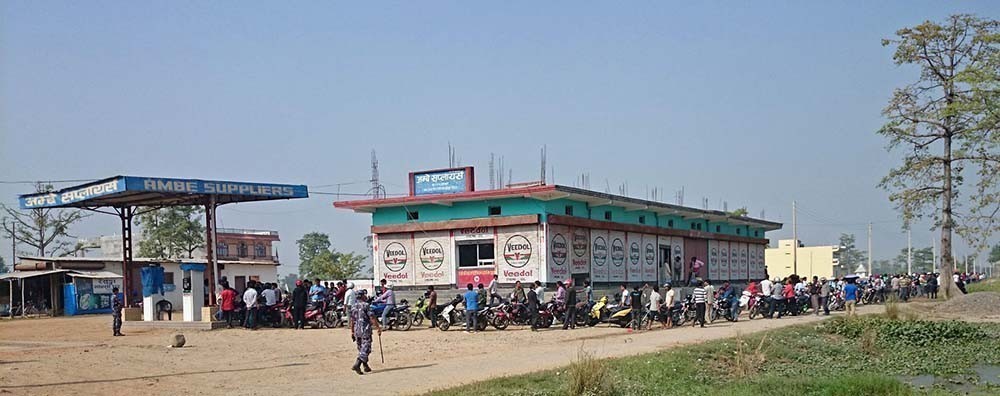
©Graham Bland. Motorcyclists queue up for gas on November 6, 2015 in Nepal.
Last We Knew: Late last year, thousands of survivors of the Gorkha earthquake in Nepal were preparing to face the winter without adequate shelter or supplies, thanks in large part to a fuel crisis that hobbled aid agencies and severely limited travel throughout the country. While geographical and infrastructure issues played a large part in hindering aid, the situation was further exacerbated by the country’s controversial constitution, which was ratified in September after years of setbacks.
Haggling over the constitution not only delayed the creation of a National Reconstruction Authority (needed to distribute $4 billion in donor funds earmarked for rebuilding), but anger over the charter’s treatment of ethnic minorities such as the Madhesi also contributed to the fuel crisis.
Nepali officials accused India—which had publically criticized the constitution and also provides all of Nepal’s fuel—of effectively launching an economic blockade. India denied those accusations, saying that the shortages were the result of the violent protests at the border of the two countries. Either way, fuel for vehicles, heat, and cooking remained lacking until recently.
The Latest: Recently, there seems to be a thaw in both obstacles to rebuilding, as well as in the relations between Nepal, the Madhesi, and India, which is closely allied with the ethnic group. In January, the National Reconstruction Authority began construction activities, as well as training for masons and engineers to help further rebuild, according to Reuters. The Authority has pledged $2,000 for each home destroyed and up to $15,000 in loans for household reconstruction.
India is also contributing to the reconstruction, agreeing to add $250 million to rebuilding efforts last week, as well as pitching in on transportation and power projects, according to an article in [Voice of America](http://bit.ly/1T5aaNm).
Perhaps more significant, however, is a return to normal levels of fuel supplies being shipped from the country. Shipments began again on Tuesday after Nepali officials were able to convince the Madhesi to end months-long protests at key border entry points, according to the [New York Times](http://nyti.ms/1QwGEt2).
Coming Up: While developments on both fronts are heartening, they aren’t without uncertainty.
Experts have warned that there aren’t enough trained masons in Nepal to adequately address the need to rebuild, especially in a seismically safe way. It’s estimated that the country will need about 50,000 masons to address the approximately 700,000 structures damaged or destroyed in the earthquake. Although a training program has been created, there’s concern that it won’t move fast enough to meet the needs of survivors who have already waited nearly a year for reconstruction.
There’s similar doubt about the lasting duration of fuel shipments. While the Madhesi have halted protests—for now—their concerns have not been formally addressed and Madhesi leaders warned that they are ready to begin again if necessary.
“We have only changed our method of protest,” Laxman Lal Karna of the United Democratic Madhesi Front told the Times. “We can again shut down the border if the government does not agree to our demands.”
The temporary nature of the truce and lack of faith in the government to maintain it could drive up demand as the Nepali public attempts to ferret away stores against what is believed to be a short-lived reprieve in the crisis.
“Everything is so uncertain here,” taxi driver Ram Tamang told the Times. “Today we have fuel, but tomorrow we could be waiting in line again. Unless the Madhesi problem is sorted out for good, this is only temporary. This is likely a brief period of relief.”
Jolie Breeden is the lead editor and science communicator for Natural Hazards Center publications. She writes and edits for Research Counts; the Quick Response, Mitigation Matters, Public Health, and Weather Ready Research Award report series; as well as for special projects and publications. Breeden graduated summa cum laude from the University of Colorado Boulder with a bachelor’s degree in journalism.